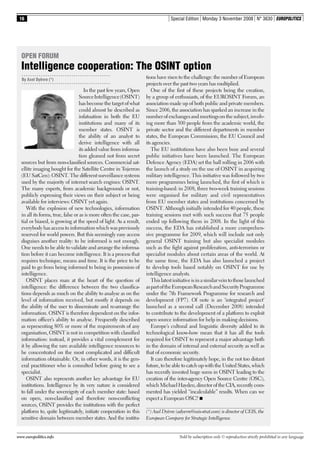
Intelligence cooperation: The OSINT option
- 1. 16 Special Edition Monday 3 November 2008 N° 3630 EUROPOLITICS OPEN FORUM Intelligence cooperation: The OSINT option tions have risen to the challenge: the number of European By Axel Dyèvre (*) projects over the past two years has multiplied. In the past few years, Open One of the first of these projects being the creation, Source Intelligence (OSINT) by a group of enthusiasts, of the EUROSINT Forum, an has become the target of what association made up of both public and private members. could almost be described as Since 2006, the association has sparked an increase in the infatuation in both the EU number of exchanges and meetings on the subject, involv- institutions and many of its ing more than 300 people from the academic world, the member states. OSINT is private sector and the different departments in member the ability of an analyst to states, the European Commission, the EU Council and derive intelligence with all its agencies. its added value from informa- The EU institutions have also been busy and several tion gleaned not from secret public initiatives have been launched. The European sources but from non-classified sources. Commercial sat- Defence Agency (EDA) set the ball rolling in 2006 with ellite imaging bought for the Satellite Centre in Tojerron the launch of a study on the use of OSINT in acquiring (EU SatCen): OSINT. The different surveillance systems military intelligence. This initiative was followed by two used by the majority of internet search engines: OSINT. more programmes being launched, the first of which is The many experts, from academic backgrounds or not, training-based: in 2008, three two-week training sessions publicly expressing their views on their subject or being were organised for military and civil representatives available for interviews: OSINT yet again. from EU member states and institutions concerned by With the explosion of new technologies, information OSINT. Although initially intended for 40 people, these in all its forms, true, false or as is more often the case, par- training sessions met with such success that 75 people tial or biased, is growing at the speed of light. As a result, ended up following them in 2008. In the light of this everybody has access to information which was previously success, the EDA has established a more comprehen- reserved for world powers. But this seemingly easy access sive programme for 2009, which will include not only disguises another reality: to be informed is not enough. general OSINT training but also specialist modules One needs to be able to validate and arrange the informa- such as the fight against proliferation, anti-terrorism or tion before it can become intelligence. It is a process that specialist modules about certain areas of the world. At requires technique, means and time. It is the price to be the same time, the EDA has also launched a project paid to go from being informed to being in possession of to develop tools based notably on OSINT for use by intelligence. intelligence analysts. OSINT places man at the heart of the question of This latest initiative is in a similar vein to those launched intelligence: the difference between the two classifica- as part of the European Research and Security Programme tions depends as much on the ability to analyse as on the under the 7th Framework Programme for research and level of information received, but mostly it depends on development (FP7). Of note is an ‘integrated project’ the ability of the user to disseminate and re-arrange the launched as a second call (December 2008) intended information. OSINT is therefore dependent on the infor- to contribute to the development of a platform to exploit mation officer’s ability to analyse. Frequently described open source information for help in making decisions. as representing 80% or more of the requirements of any Europe’s cultural and linguistic diversity added to its organisation, OSINT is not in competition with classified technological know-how mean that it has all the tools information: instead, it provides a vital complement for required for OSINT to represent a major advantage both it by allowing the rare available intelligence resources to in the domain of internal and external security as well as be concentrated on the most complicated and difficult that of economic security. information obtainable. Or, in other words, it is the gen- It can therefore legitimately hope, in the not too distant eral practitioner who is consulted before going to see a future, to be able to catch up with the United States, which specialist. has recently invested huge sums in OSINT leading to the OSINT also represents another key advantage for EU creation of the inter-agency Open Source Centre (OSC), institutions. Intelligence by its very nature is considered which Michael Hayden, director of the CIA, recently com- to fall under the sovereignty of each member state: based mented has yielded “incalculable” results. When can we on open, non-classified and therefore non-conflicting expect a European OSC? ! sources, OSINT provides the institutions with the perfect platform to, quite legitimately, initiate cooperation in this (*) Axel Dyèvre (adyevre@ceis-strat.com) is director of CEIS, the sensitive domain between member states. And the institu- European Company for Strategic Intelligence. www.europolitics.info Sold by subscription only © reproduction strictly prohibited in any language
